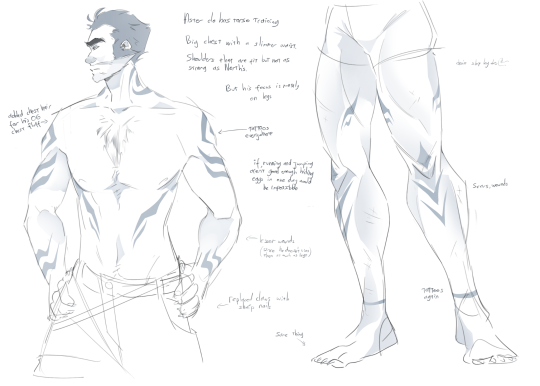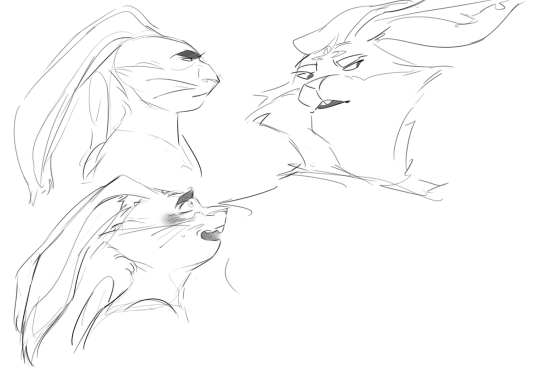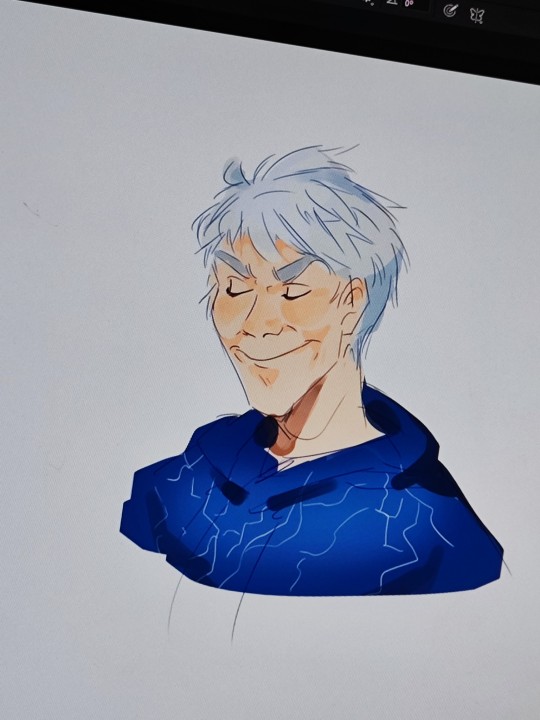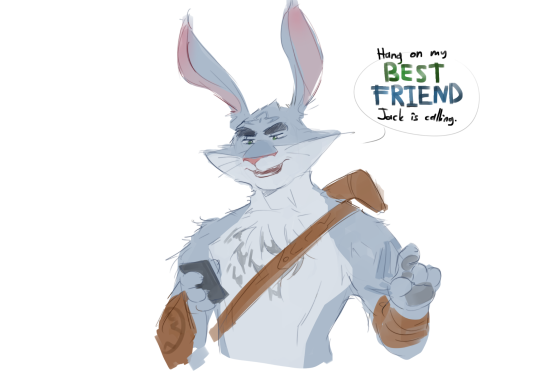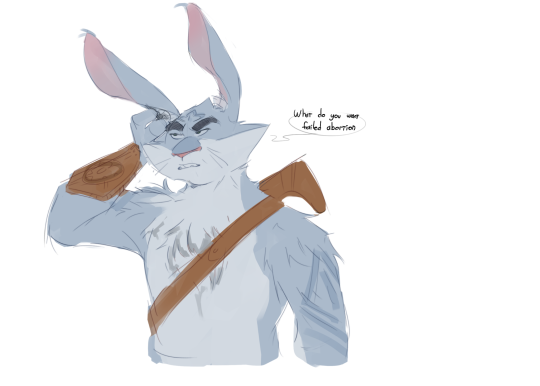Text
My articles and reference posts
A master post of recommended sources for the study of my interests can be found here. If possible, consult it before sending any research-oriented questions.
Ancient Mesopotamia and its neighbors:
Who is Baal, anyway?
The Two (or more) Ishtars or A Certain Scandalous Easter Claim Proved to be The Worship of Reverend Alexander Hislop
The long journey of Pinikir - a different tale of two (or more) Ishtars
Five Mesoptamian gods you haven’t heard about
“A repository for the exotic and the unusual.” Mesopotamian gods of the underworld
400 followers special: the Kumarbi cycle
Pride Month special: Manzat, the deified rainbow and her LGBT connection
Myths about myths: the case of Enuma Elish
A Megaten apocalypse: the sad case of Inanna
Arahsamnum 2021, a series of 18 articles about underworld-related deities
Aya and Shala: divine wives
Women, goddesses and writing in ancient Mesopotamia
Ninshubur, Inanna’s Sukkal: Just a Servant or Something More?
Christmas special: Santa and his helpers. Divine living fossils in Greek sources
Ishkur, Baal, and others: a guide to the weather gods of Mesopotamia and ancient Syria
The most important deity you’ve never heard of: the 3000 years long history of Nanaya
various trivia which do not warrant full articles can be found in the Mesopotamian miscellanea, Ugaritic miscellanea, Anatolian miscellanea etc. tags
Also make sure to check out the Monthly Wikipedia repair roundup (formerly Weekly Wikipedia repair roundup) tag.
Japanese religions and art:
Matara-jin and associated figures - English language resources masterpost
300 followers special: debunking Arahabaki
Japanese epidemic deities
The Ten Kings of Hell: a history
Tamamizu Monogatari, a unique love story
The fabrication of a storm god: Susanoo, Taishakuten (Indra) and their histories
Tenshō Daijin: the many guises of medieval Amaterasu part 1 and part 2
Shikigami and onmyōdō through history: truth, fiction and everything in between
Various trivia which do not warrant full articles can be found in the Japanese miscellanea and genpeiposting tags.
Chinese religions and art:
Taotie as a monster and an art motif
“Nine-headed hermit”: the early history of Zhong Kui (and his sister)
Touhou and mythology:
As of 2024, this series of articles is on indeterminate hiatus and unlikely to ever return.
Horned hermits and immoral immortals: an inquiry into Zanmu’s background
Consulting the convoluted history of supernatural foxes, or why is Tsukasa like that
“Roaming into immortality”: Ten Desires and the history of Taoist immortals
1000 followers special: the history of the hakutaku
Demon king, demigod, drunkard, dōji: exploring the archetypal oni, from Ōeyama to Lotus Eaters
Mai, Satono and their peers: a look into the world of dōji
Revenge of the “graveyard god”, or why I don’t think Ran is Tamamo no Mae
“A god of tengu-warding”: uncovering the connection between Okina and tengu
“Tenma, boss of the tengu”. Exploring the “heavenly demon(s)”
Miscellanea:
Hecate: falsehoods and myths
A hidden world that never was: witch cults, matriarchal prehistory and contemporary conspiracy theories
The Contendings of History and Seth
Circe by Madeline Miller: a review
SMT V and mythology
293 notes
·
View notes
Text
Shikigami and onmyōdō through history: truth, fiction and everything in between
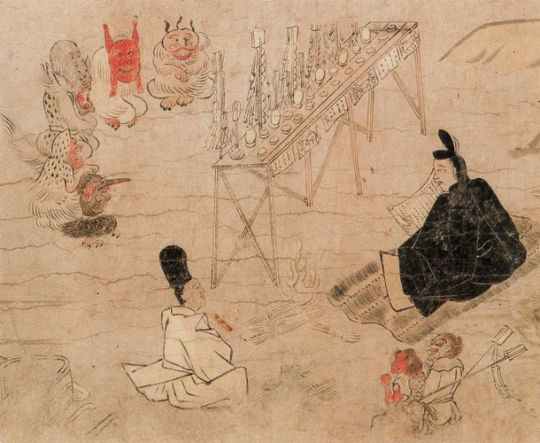
Abe no Seimei exorcising disease spirits (疫病神, yakubyōgami), as depicted in the Fudō Riyaku Engi Emaki. Two creatures who might be shikigami are visible in the bottom right corner (wikimedia commons; identification following Bernard Faure’s Rage and Ravage, pp. 57-58)
In popular culture, shikigami are basically synonymous with onmyōdō. Was this always the case, though? And what is a shikigami, anyway? These questions are surprisingly difficult to answer. I’ve been meaning to attempt to do so for a longer while, but other projects kept getting in the way. Under the cut, you will finally be able to learn all about this matter.
This isn’t just a shikigami article, though. Since historical context is a must, I also provide a brief history of onmyōdō and some of its luminaries. You will also learn if there were female onmyōji, when stars and time periods turn into deities, what onmyōdō has to do with a tale in which Zhong Kui became a king of a certain city in India - and more!
The early days of onmyōdō In order to at least attempt to explain what the term shikigami might have originally entailed, I first need to briefly summarize the history of onmyōdō (陰陽道). This term can be translated as “way of yin and yang”, and at the core it was a Japanese adaptation of the concepts of, well, yin and yang, as well as the five elements. They reached Japan through Daoist and Buddhist sources. Daoism itself never really became a distinct religion in Japan, but onmyōdō is arguably among the most widespread adaptations of its principles in Japanese context.
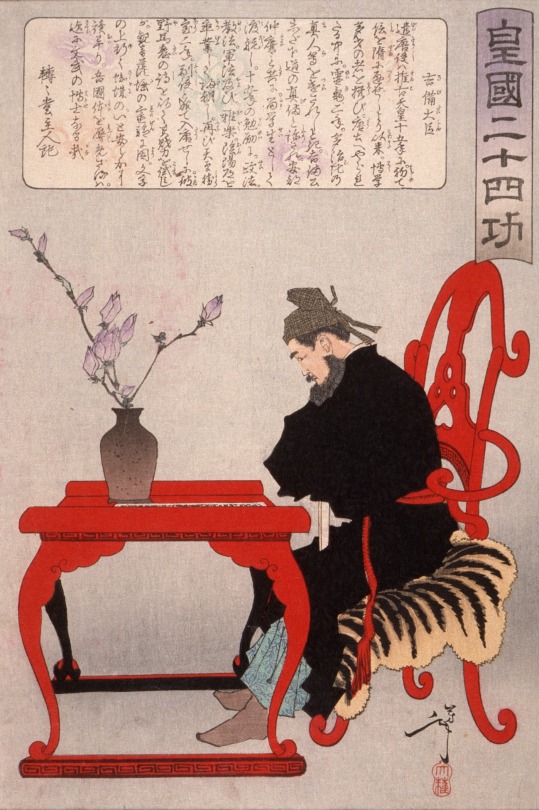
Kibi no Makibi, as depicted by Yoshitoshi Tsukioka (wikimedia commons)
It’s not possible to speak of a singular founder of onmyōdō comparable to the patriarchs of Buddhist schools. Bernard Faure notes that in legends the role is sometimes assigned to Kibi no Makibi, an eighth century official who spent around 20 years in China. While he did bring many astronomical treatises with him when he returned, this is ultimately just a legend which developed long after he passed away.
In reality onmyōdō developed gradually starting with the sixth century, when Chinese methods of divination and treatises dealing with these topics first reached Japan. Early on Buddhist monks from the Korean kingdom of Baekje were the main sources of this knowledge. We know for example that the Soga clan employed such a specialist, a certain Gwalleuk (観勒; alternatively known under the Japanese reading of his name, Kanroku).
Obviously, divination was viewed as a very serious affair, so the imperial court aimed to regulate the continental techniques in some way. This was accomplished by emperor Tenmu with the formation of the onmyōryō (陰陽寮), “bureau of yin and yang” as a part of the ritsuryō system of governance. Much like in China, the need to control divination was driven by the fears that otherwise it would be used to legitimize courtly intrigues against the emperor, rebellions and other disturbances. Officials taught and employed by onmyōryō were referred to as onmyōji (陰陽師). This term can be literally translated as “yin-yang master”. In the Nara period, they were understood essentially as a class of public servants. Their position didn’t substantially differ from that of other specialists from the onmyōryō: calendar makers, officials responsible for proper measurement of time and astrologers. The topics they dealt with evidently weren’t well known among commoners, and they were simply typical members of the literate administrative elite of their times.
Onmyōdō in the Heian period: magic, charisma and nobility
The role of onmyōji changed in the Heian period. They retained the position of official bureaucratic diviners in employ of the court, but they also acquired new duties. The distinction between them and other onmyōryō officials became blurred. Additionally their activity extended to what was collectively referred to as jujutsu (呪術), something like “magic” though this does not fully reflect the nuances of this term. They presided over rainmaking rituals, purification ceremonies, so-called “earth quelling”, and establishing complex networks of temporal and directional taboos.
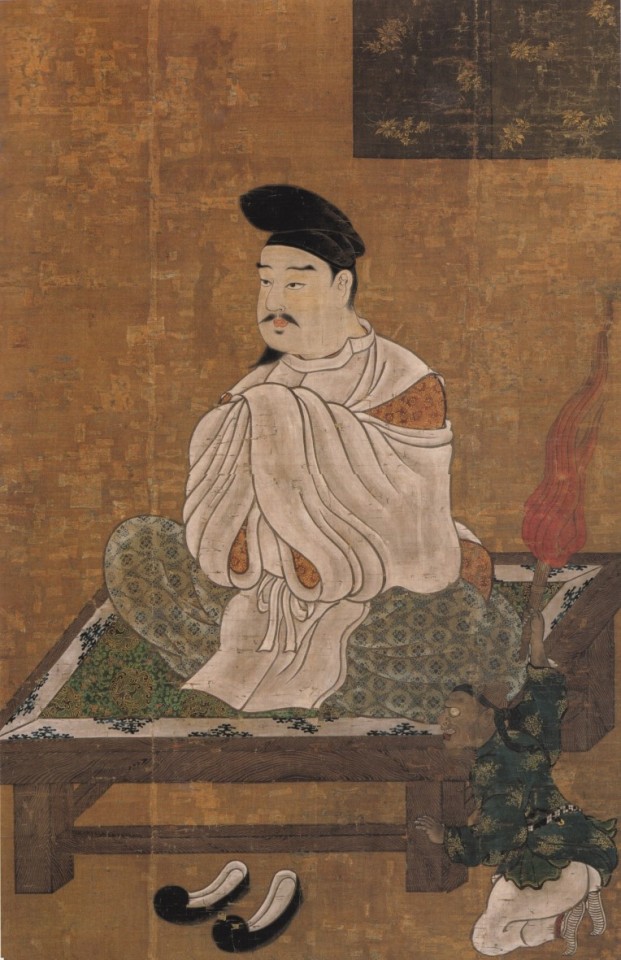
A Muromachi period depiction of Abe no Seimei (wikimedia commons)
The most famous historical onmyōji like Kamo no Yasunori and his student Abe no Seimei were active at a time when this version of onmyōdō was a fully formed - though obviously still evolving - set of practices and beliefs. In a way they represented a new approach, though - one in which personal charisma seemed to matter just as much, if not more, than official position. This change was recognized as a breakthrough by at least some of their contemporaries. For example, according to the diary of Minamoto no Tsuneyori, the Sakeiki (左經記), “in Japan, the foundations of onmyōdō were laid by Yasunori”.
The changes in part reflected the fact that onmyōji started to be privately contracted for various reasons by aristocrats, in addition to serving the state. Shin’ichi Shigeta notes that it essentially turned them from civil servants into tradespeople. However, he stresses they cannot be considered clergymen: their position was more comparable to that of physicians, and there is no indication they viewed their activities as a distinct religion. Indeed, we know of multiple Heian onmyōji, like Koremune no Fumitaka or Kamo no Ieyoshi, who by their own admission were devout Buddhists who just happened to work as professional diviners.
Shin’ichi Shigeta notes is evidence that in addition to the official, state-sanctioned onmyōji, “unlicensed” onmyōji who acted and dressed like Buddhist clergy, hōshi onmyōji (法師陰陽師) existed. The best known example is Ashiya Dōman, a mainstay of Seimei legends, but others are mentioned in diaries, including the famous Pillow Book. It seems nobles particularly commonly employed them to curse rivals. This was a sphere official onmyōji abstained from due to legal regulations. Curses were effectively considered crimes, and government officials only performed apotropaic rituals meant to protect from them. The Heian period version of onmyōdō captivated the imagination of writers and artists, and its slightly exaggerated version present in classic literature like Konjaku Monogatari is essentially what modern portrayals in fiction tend to go back to.
Medieval onmyōdō: from abstract concepts to deities
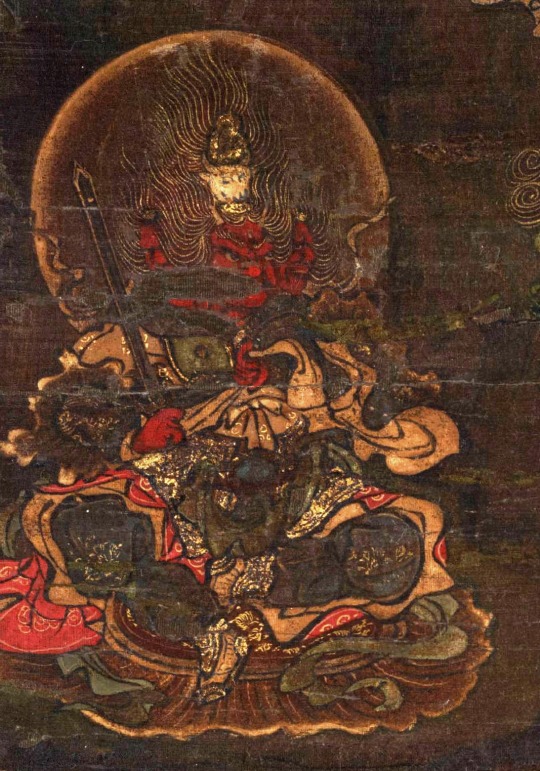
Gozu Tennō (wikimedia commons)
Further important developments occurred between the twelfth and fourteenth centuries. This period was the beginning of the Japanese “middle ages” which lasted all the way up to the establishment of the Tokugawa shogunate. The focus in onmyōdō in part shifted towards new, or at least reinvented, deities, such as calendarical spirits like Daishōgun (大将軍) and Ten’ichijin (天一神), personifications of astral bodies and concepts already crucial in earlier ceremonies. There was also an increased interest in Chinese cosmological figures like Pangu, reimagined in Japan as “king Banko”. However, the most famous example is arguably Gozu Tennō, who you might remember from my Susanoo article.
The changes in medieval onmyōdō can be described as a process of convergence with esoteric Buddhism. The points of connection were rituals focused on astral and underworld deities, such as Taizan Fukun or Shimei (Chinese Siming). Parallels can be drawn between this phenomenon and the intersection between esoteric Buddhism and some Daoist schools in Tang China. Early signs of the development of a direct connection between onmyōdō and Buddhism can already be found in sources from the Heian period, for example Kamo no Yasunori remarked that he and other onmyōji depend on the same sources to gain proper understanding of ceremonies focused on the Big Dipper as Shingon monks do.
Much of the information pertaining to the medieval form of onmyōdō is preserved in Hoki Naiden (ほき内伝; “Inner Tradition of the Square and the Round Offering Vessels”), a text which is part divination manual and part a collection of myths. According to tradition it was compiled by Abe no Seimei, though researchers generally date it to the fourteenth century. For what it’s worth, it does seem likely its author was a descendant of Seimei, though. Outside of specialized scholarship Hoki Naiden is fairly obscure today, but it’s worth noting that it was a major part of the popular perception of onmyōdō in the Edo period. A novel whose influence is still visible in the modern image of Seimei, Abe no Seimei Monogatari (安部晴明物語), essentially revolves around it, for instance.
Onmyōdō in the Edo period: occupational licensing
Novels aside, the first post-medieval major turning point for the history of onmyōdō was the recognition of the Tsuchimikado family as its official overseers in 1683. They were by no means new to the scene - onmyōji from this family already served the Ashikaga shoguns over 250 years earlier. On top of that, they were descendants of the earlier Abe family, the onmyōji par excellence. The change was not quite the Tsuchimikado’s rise, but rather the fact the government entrusted them with essentially regulating occupational licensing for all onmyōji, even those who in earlier periods existed outside of official administration.
As a result of the new policies, various freelance practitioners could, at least in theory, obtain a permit to perform the duties of an onmyōji. However, as the influence of the Tsuchimikado expanded, they also sought to oblige various specialists who would not be considered onmyōji otherwise to purchase licenses from them. Their aim was to essentially bring all forms of divination under their control. This extended to clergy like Buddhist monks, shugenja and shrine priests on one hand, and to various performers like members of kagura troupes on the other.
Makoto Hayashi points out that while throughout history onmyōji has conventionally been considered a male occupation, it was possible for women to obtain licenses from the Tsuchimikado. Furthermore, there was no distinct term for female onmyōji, in contrast with how female counterparts of Buddhist monks, shrine priests and shugenja were referred to with different terms and had distinct roles defined by their gender. As far as I know there’s no earlier evidence for female onmyōji, though, so it’s safe to say their emergence had a lot to do with the specifics of the new system. It seems the poems of the daughter of Kamo no Yasunori (her own name is unknown) indicate she was familiar with yin-yang theory or at least more broadly with Chinese philosophy, but that’s a topic for a separate article (stay tuned), and it's not quite the same, obviously.
The Tsuchimikado didn’t aim to create a specific ideology or systems of beliefs. Therefore, individual onmyōji - or, to be more accurate, individual people with onmyōji licenses - in theory could pursue new ideas. This in some cases lead to controversies: for instance, some of the people involved in the (in)famous 1827 Osaka trial of alleged Christians (whether this label really is applicable is a matter of heated debate) were officially licensed onmyōji. Some of them did indeed possess translated books written by Portuguese missionaries, which obviously reflected Catholic outlook. However, Bernard Faure suggests that some of the Edo period onmyōji might have pursued Portuguese sources not strictly because of an interest in Catholicism but simply to obtain another source of astronomical knowledge.
The legacy of onmyōdō
In the Meiji period, onmyōdō was banned alongside shugendō. While the latter tradition experienced a revival in the second half of the twentieth century, the former for the most part didn’t. However, that doesn’t mean the history of onmyōdō ends once and for all in the second half of the nineteenth century.
Even today in some parts of Japan there are local religious traditions which, while not identical with historical onmyōdō, retain a considerable degree of influence from it. An example often cited in scholarship is Izanagi-ryū (いざなぎ流) from the rural Monobe area in the Kōchi Prefecture. Mitsuki Ueno stresses that the occasional references to Izanagi-ryū as “modern onmyōdō” in literature from the 1990s and early 2000s are inaccurate, though. He points out they downplay the unique character of this tradition, and that it shows a variety of influences. Similar arguments have also been made regarding local traditions from the Chūgoku region.
Until relatively recently, in scholarship onmyōdō was basically ignored as superstition unworthy of serious inquiries. This changed in the final decades of the twentieth century, with growing focus on the Japanese middle ages among researchers. The first monographs on onmyōdō were published in the 1980s. While it’s not equally popular as a subject of research as esoteric Buddhism and shugendō, formerly neglected for similar reasons, it has nonetheless managed to become a mainstay of inquiries pertaining to the history of religion in Japan.
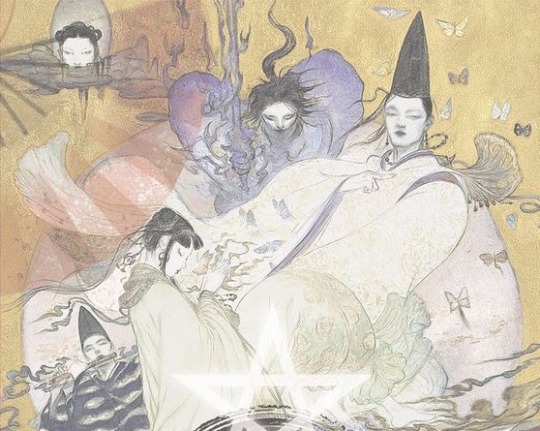
Yoshitaka Amano's illustration of Baku Yumemakura's fictionalized portrayal of Abe no Seimei (right) and other characters from his novels (reproduced here for educational purposes only)
Of course, it’s also impossible to talk about onmyōdō without mentioning the modern “onmyōdō boom”. Starting with the 1980s, onmyōdō once again became a relatively popular topic among writers. Novel series such as Baku Yumemakura’s Onmyōji, Hiroshi Aramata’s Teito Monogatari or Natsuhiko Kyōgoku’s Kyōgōkudō and their adaptations in other media once again popularized it among general audiences. Of course, since these are fantasy or mystery novels, their historical accuracy tends to vary (Yumemakura in particular is reasonably faithful to historical literature, though). Still, they have a lasting impact which would be impossible to accomplish with scholarship alone.
Shikigami: historical truth, historical fiction, or both?
You might have noticed that despite promising a history of shikigami, I haven’t used this term even once through the entire crash course in history of onmyōdō. This was a conscious choice. Shikigami do not appear in any onmyōdō texts, even though they are a mainstay of texts about onmyōdō, and especially of modern literature involving onmyōji.
It would be unfair to say shikigami and their prominence are merely a modern misconception, though. Virtually all of the famous legends about onmyōji feature shikigami, starting with the earliest examples from the eleventh century. Based on Konjaku Monogatari, there evidently was a fascination with shikigami at the time of its compilation. Fujiwara no Akihira in the Shinsarugakuki treats the control of shikigami as an essential skill of an onmyōji, alongside the abilities to “freely summon the twelve guardian deities, call thirty-six types of wild birds (...), create spells and talismans, open and close the eyes of kijin (鬼神; “demon gods”), and manipulate human souls”.
It is generally agreed that such accounts, even though they belong to the realm of literary fiction, can shed light on the nature and importance of shikigami. They ultimately reflect their historical context to some degree. Furthermore, it is not impossible that popular understanding of shikigami based on literary texts influenced genuine onmyōdō tradition. It’s worth pointing out that today legends about Abe no Seimei involving them are disseminated by two contemporary shrines dedicated to him, the Seimei Shrine (晴明神社) in Kyoto and the Abe no Seimei Shrine (安倍晴明神社) in Osaka. Interconnected networks of exchange between literature and religious practice are hardly a unique or modern phenomenon.
However, even with possible evidence from historical literature taken into account, it is not easy to define shikigami. The word itself can be written in three different ways: 式神 (or just 式), 識神 and 職神, with the first being the default option. The descriptions are even more varied, which understandably lead to the rise of numerous interpretations in modern scholarship. Carolyn Pang in her recent treatments of shikigami, which you can find in the bibliography, has recently divided them into five categories. I will follow her classification below.
Shikigami take 1: rikujin-shikisen
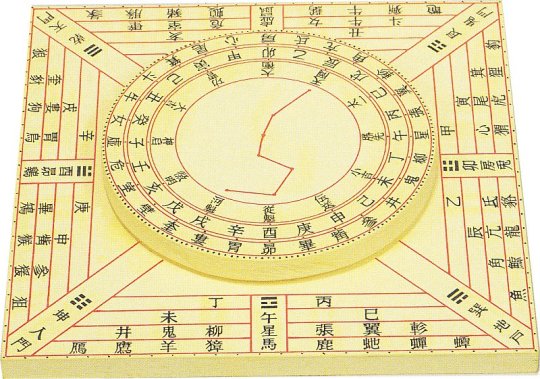
An example of shikiban, the divination board used in rikujin-shikisen (Museum of Kyoto, via onmarkproductions.com; reproduced here for educational purposes only)
A common view is that shikigami originate as a symbolic representation of the power of shikisen (式占) or more specifically rikujin-shikisen (六壬式占), the most common form of divination in onmyōdō. It developed from Chinese divination methods in the Nara period, and remained in the vogue all the way up to the sixteenth century, when it was replaced by ekisen (易占), a method derived from the Chinese Book of Changes.
Shikisen required a special divination board known as shikiban (式盤), which consists of a square base, the “earth panel” (地盤, jiban), and a rotating circle placed on top of it, the “heaven panel” (天盤, tenban). The former was marked with twelve points representing the signs of the zodiac and the latter with representations of the “twelve guardians of the months” (十二月将, jūni-gatsushō; their identity is not well defined). The heaven panel had to be rotated, and the diviner had to interpret what the resulting combination of symbols represents. Most commonly, it was treated as an indication whether an unusual phenomenon (怪/恠, ke) had positive or negative implications. It’s worth pointing out that in the middle ages the shikiban also came to be used in some esoteric Buddhist rituals, chiefly these focused on Dakiniten, Shōten and Nyoirin Kannon. However, they were only performed between the late Heian and Muromachi periods, and relatively little is known about them. In most cases the divination board was most likely modified to reference the appropriate esoteric deities.
Shikigami take 2: cognitive abilities
While the view that shikigami represented shikisen is strengthened by the fact both terms share the kanji 式, a variant writing, 識神, lead to the development of another proposal. Since the basic meaning of 識 is “consciousness”, it is sometimes argued that shikigami were originally an “anthropomorphic realization of the active psychological or mental state”, as Caroline Pang put it - essentially, a representation of the will of an onmyōji. Most of the potential evidence in this case comes from Buddhist texts, such as Bosatsushotaikyō (菩薩処胎経).
However, Bernard Faure assumes that the writing 識神 was a secondary reinterpretation, basically a wordplay based on homonymy. He points out the Buddhist sources treat this writing of shikigami as a synonym of kushōjin (倶生神). This term can be literally translated as “deities born at the same time”. Most commonly it designates a pair of minor deities who, as their name indicates, come into existence when a person is born, and then records their deeds through their entire life. Once the time for Enma’s judgment after death comes, they present him with their compiled records. It has been argued that they essentially function like a personification of conscience.
Shikigami take 3: energy
A further speculative interpretation of shikigami in scholarship is that this term was understood as a type of energy present in objects or living beings which onmyōji were believed to be capable of drawing out and harnessing to their ends. This could be an adaptation of the Daoist notion of qi (氣). If this definition is correct, pieces of paper or wooden instruments used in purification ceremonies might be examples of objects utilized to channel shikigami.
The interpretation of shikigami as a form of energy is possibly reflected in Konjaku Monogatari in the tale The Tutelage of Abe no Seimei under Tadayuki. It revolves around Abe no Seimei’s visit to the house of the Buddhist monk Kuwanten from Hirosawa. Another of his guests asks Seimei if he is capable of killing a person with his powers, and if he possesses shikigami. He affirms that this is possible, but makes it clear that it is not an easy task. Since the guests keep urging him to demonstrate nonetheless, he promptly demonstrates it using a blade of grass. Once it falls on a frog, the animal is instantly crushed to death. From the same tale we learn that Seimei’s control over shikigami also let him remotely close the doors and shutters in his house while nobody was inside.
Shikigami take 4: curse As I already mentioned, arts which can be broadly described as magic - like the already mentioned jujutsu or juhō (呪法, “magic rituals”) - were regarded as a core part of onmyōji’s repertoire from the Heian period onward. On top of that, the unlicensed onmyōji were almost exclusively associated with curses. Therefore, it probably won’t surprise you to learn that yet another theory suggests shikigami is simply a term for spells, curses or both. A possible example can be found in Konjaku Monogatari, in the tale Seimei sealing the young Archivist Minor Captains curse - the eponymous curse, which Seimei overcomes with protective rituals, is described as a shikigami.

Kunisuda Utagawa's illustration of an actor portraying Dōman in a kabuki play (wikimedia commons)
Similarities between certain descriptions of shikigami and practices such as fuko (巫蠱) and goraihō (五雷法) have been pointed out. Both of these originate in China. Fuko is the use of poisonous, venomous or otherwise negatively perceived animals to create curses, typically by putting them in jars, while goraihō is the Japanese version of Daoist spells meant to control supernatural beings, typically ghosts or foxes. It’s worth noting that a legend according to which Dōman cursed Fujiwara no Michinaga on behalf of lord Horikawa (Fujiwara no Akimitsu) involves him placing the curse - which is itself not described in detail - inside a jar.
Mitsuki Ueno notes that in the Kōchi Prefecture the phrase shiki wo utsu, “to strike with a shiki”, is still used to refer to cursing someone. However, shiki does not necessarily refer to shikigami in this context, but rather to a related but distinct concept - more on that later.
Shikigami take 5: supernatural being
While all four definitions I went through have their proponents, yet another option is by far the most common - the notion of shikigami being supernatural beings controlled by an onmyōji. This is essentially the standard understanding of the term today among general audiences. Sometimes attempts are made to identify it with a specific category of supernatural beings, like spirits (精霊, seirei), kijin or lesser deities (下級神, kakyū shin). However, none of these gained universal support. Generally speaking, there is no strong indication that shikigami were necessarily imagined as individualized beings with distinct traits.
The notion of shikigami being supernatural beings is not just a modern interpretation, though, for the sake of clarity. An early example where the term is unambiguously used this way is a tale from Ōkagami in which Seimei sends a nondescript shikigami to gather information. The entity, who is not described in detail, possesses supernatural skills, but simultaneously still needs to open doors and physically travel.
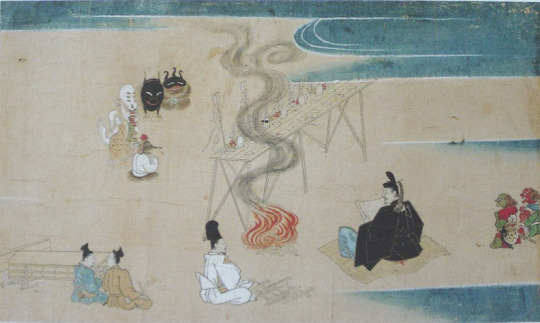
An illustration from Nakifudō Engi Emaki (wikimedia commons)
In Genpei Jōsuiki there is a reference to Seimei’s shikigami having a terrifying appearance which unnerved his wife so much he had to order the entities to hide under a bride instead of residing in his house. Carolyn Pang suggests that this reflects the demon-like depictions from works such as Abe no Seimei-kō Gazō (安倍晴明公画像; you can see it in the Heian section), Fudōriyaku Engi Emaki and Nakifudō Engi Emaki.
Shikigami and related concepts

A gohō dōji, as depicted in the Shigisan Engi Emaki (wikimedia commons)
The understanding of shikigami as a “spirit servant” of sorts can be compared with the Buddhist concept of minor protective deities, gohō dōji (護法童子; literally “dharma-protecting lads”). These in turn were just one example of the broad category of gohō (護法), which could be applied to virtually any deity with protective qualities, like the historical Buddha’s defender Vajrapāṇi or the Four Heavenly Kings. A notable difference between shikigami and gohō is the fact that the former generally required active summoning - through chanting spells and using mudras - while the latter manifested on their own in order to protect the pious. Granted, there are exceptions. There is a well attested legend according to which Abe no Seimei’s shikigami continued to protect his residence on own accord even after he passed away. Shikigami acting on their own are also mentioned in Zoku Kojidan (続古事談). It attributes the political downfall of Minamoto no Takaakira (源高明; 914–98) to his encounter with two shikigami who were left behind after the onmyōji who originally summoned them forgot about them.
A degree of overlap between various classes of supernatural helpers is evident in texts which refer to specific Buddhist figures as shikigami. I already brought up the case of the kushōjin earlier. Another good example is the Tendai monk Kōshū’s (光宗; 1276–1350) description of Oto Gohō (乙護法). He is “a shikigami that follows us like the shadow follows the body. Day or night, he never withdraws; he is the shikigami that protects us” (translation by Bernard Faure). This description is essentially a reversal of the relatively common title “demon who constantly follow beings” (常随魔, jōzuima). It was applied to figures such as Kōjin, Shōten or Matarajin, who were constantly waiting for a chance to obstruct rebirth in a pure land if not placated properly.
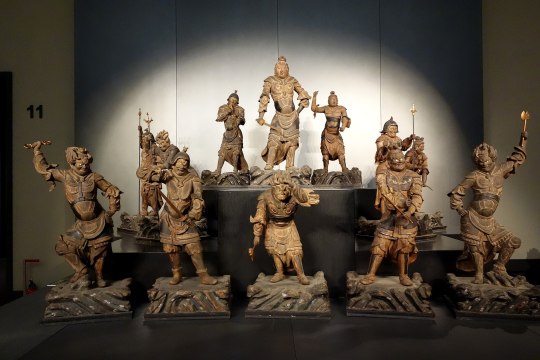
The Twelve Heavenly Generals (Tokyo National Museum, via wikimedia commons)
A well attested group of gohō, the Twelve Heavenly Generals (十二神将, jūni shinshō), and especially their leader Konpira (who you might remember from my previous article), could be labeled as shikigami. However, Fujiwara no Akihira’s description of onmyōji skills evidently presents them as two distinct classes of beings.
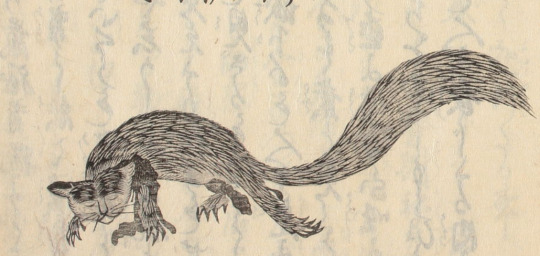
A kuda-gitsune, as depicted in Shōzan Chomon Kishū by Miyoshi Shōzan (Waseda University History Museum; reproduced here for educational purposes only)
Granted, Akihira also makes it clear that controlling shikigami and animals are two separate skills. Meanwhile, there is evidence that in some cases animal familiars, especially kuda-gitsune used by iizuna (a term referring to shugenja associated with the cult of, nomen omen, Iizuna Gongen, though more broadly also something along the lines of “sorcerer”), were perceived as shikigami.
Beliefs pertaining to gohō dōji and shikigami seemingly merged in Izanagi-ryū, which lead to the rise of the notion of shikiōji (式王子; ōji, literally “prince”, can be another term for gohō dōji). This term refers to supernatural beings summoned by a ritual specialist (祈祷師, kitōshi) using a special formula from doctrinal texts (法文, hōmon). They can fulfill various functions, though most commonly they are invoked to protect a person, to remove supernatural sources of diseases, to counter the influence of another shikiōji or in relation to curses.
Tenkeisei, the god of shikigami

Tenkeisei (wikimedia commons)
The final matter which warrants some discussion is the unusual tradition regarding the origin of shikigami which revolves around a deity associated with this concept.
In the middle ages, a belief that there were exactly eighty four thousand shikigami developed. Their source was the god Tenkeisei (天刑星; also known as Tengyōshō). His name is the Japanese reading of Chinese Tianxingxing. It can be translated as “star of heavenly punishment”. This name fairly accurately explains his character. He was regarded as one of the so-called “baleful stars” (凶星, xiong xing) capable of controlling destiny. The “punishment” his name refers to is his treatment of disease demons (疫鬼, ekiki). However, he could punish humans too if not worshiped properly.
Today Tenkeisei is best known as one of the deities depicted in a series of paintings known as Extermination of Evil, dated to the end of the twelfth century. He has the appearance of a fairly standard multi-armed Buddhist deity. The anonymous painter added a darkly humorous touch by depicting him right as he dips one of the defeated demons in vinegar before eating him. Curiously, his adversaries are said to be Gozu Tennō and his retinue in the accompanying text. This, as you will quickly learn, is a rather unusual portrayal of the relationship between these two deities.
I’m actually not aware of any other depictions of Tenkeisei than the painting you can see above. Katja Triplett notes that onmyōdō rituals associated with him were likely surrounded by an aura of secrecy, and as a result most depictions of him were likely lost or destroyed. At the same time, it seems Tenkeisei enjoyed considerable popularity through the Kamakura period. This is not actually paradoxical when you take the historical context into account: as I outlined in my recent Amaterasu article, certain categories of knowledge were labeled as secret not to make their dissemination forbidden, but to imbue them with more meaning and value.
Numerous talismans inscribed with Tenkeisei’s name are known. Furthermore, manuals of rituals focused on him have been discovered. The best known of them, Tenkeisei-hō (天刑星法; “Tenkeisei rituals”), focuses on an abisha (阿尾捨, from Sanskrit āveśa), a ritual involving possession by the invoked deity. According to a legend was transmitted by Kibi no Makibi and Kamo no Yasunori. The historicity of this claim is doubtful, though: the legend has Kamo no Yasunori visit China, which he never did. Most likely mentioning him and Makibi was just a way to provide the text with additional legitimacy.
Other examples of similar Tenkeisei manuals include Tenkeisei Gyōhō (天刑星行法; “Methods of Tenkeisei Practice”) and Tenkeisei Gyōhō Shidai (天刑星行法次第; “Methods of Procedure for the Tenkeisei Practice”). Copies of these texts have been preserved in the Shingon temple Kōzan-ji.
The Hoki Naiden also mentions Tenkeisei. It equates him with Gozu Tennō, and explains both of these names refer to the same deity, Shōki (商貴), respectively in heaven and on earth. While Shōki is an adaptation of the famous Zhong Kui, it needs to be pointed out that here he is described not as a Tang period physician but as an ancient king of Rajgir in India. Furthermore, he is a yaksha, not a human. This fairly unique reinterpretation is also known from the historical treatise Genkō Shakusho. Post scriptum The goal of this article was never to define shikigami. In the light of modern scholarship, it’s basically impossible to provide a single definition in the first place. My aim was different: to illustrate that context is vital when it comes to understanding obscure historical terms. Through history, shikigami evidently meant slightly different things to different people, as reflected in literature. However, this meaning was nonetheless consistently rooted in the evolving perception of onmyōdō - and its internal changes. In other words, it reflected a world which was fundamentally alive. The popular image of Japanese culture and religion is often that of an artificial, unchanging landscape straight from the “age of the gods”, largely invented in the nineteenth century or later to further less than noble goals. The case of shikigami proves it doesn’t need to be, though. The malleable, ever-changing image of shikigami, which remained a subject of popular speculation for centuries before reemerging in a similar role in modern times, proves that the more complex reality isn’t necessarily any less interesting to new audiences.
Bibliography
Bernard Faure, A Religion in Search of a Founder?
Idem, Rage and Ravage (Gods of Medieval Japan vol. 3)
Makoto Hayashi, The Female Christian Yin-Yang Master
Jun’ichi Koike, Onmyōdō and Folkloric Culture: Three Perspectives for the Development of Research
Irene H. Lin, Child Guardian Spirits (Gohō Dōji) in the Medieval Japanese Imaginaire
Yoshifumi Nishioka, Aspects of Shikiban-Based Mikkyō Rituals
Herman Ooms, Yin-Yang's Changing Clientele, 600-800 (note there is n apparent mistake in one of the footnotes, I'm pretty sure the author wanted to write Mesopotamian astronomy originated 4000 years ago, not 4 millenia BCE as he did; the latter date makes little sense)
Carolyn Pang, Spirit Servant: Narratives of Shikigami and Onmyōdō Developments
Idem, Uncovering Shikigami. The Search for the Spirit Servant of Onmyōdō
Shin’ichi Shigeta, Onmyōdō and the Aristocratic Culture of Everyday Life in Heian Japan
Idem, A Portrait of Abe no Seimei
Katja Triplett, Putting a Face on the Pathogen and Its Nemesis. Images of Tenkeisei and Gozutennō, Epidemic-Related Demons and Gods in Medieval Japan
Mitsuki Umeno, The Origins of the Izanagi-ryū Ritual Techniques: On the Basis of the Izanagi saimon
Katsuaki Yamashita, The Characteristics of On'yōdō and Related Texts
199 notes
·
View notes
Note
What are the weaknesses of a fox spirit and what abilities do they have according to myths and stories?
Off the top of my head:
-Dogs. Specifically, hunting hounds. "Fox spirits fear hounds" is kinda common knowledge for the Zhiguai genre, but there are exceptions: both Soushen Ji and You Yang Za Zu had mentioned that 1000 years old foxes/heavenly foxes did not fear hounds, and in the Qing dynasty, that expanded to include "fox immortals", basically cultivator foxes.
-Daoist talismans + peachwood + mirrors + enchanted swords. This isn't fox-specific, work on other yaoguais a/o ghosts too.
-Five Thunder Arts isn't fox-specific either, but got used against foxes a lot in Qing legends. Jiang Ziya used it against Daji and her demonic sisters in FSYY Chapter 96, causing them to abort the raid on the Zhou camp out of fear.
-Any gods that are more powerful than them: Chenghuang, Lady of Mt. Tai a.k.a. Bixia Yuanjun, Guan Yu, Zhong Kui, Thunder Bureau deities...
-A weird one from Guangyi Ji and other Tang compendiums: burning magpie nests + hanging up magpie heads.
-A real funny one, brought up in Yuewei Caotang Biji: daredevils and people who are plain angry assholes. It doesn't always work and has a not-too-small chance of backfiring, but regular fox spirits could often be scared off by a mortal who's not afraid to give them a piece of their mind.
As for abilities:
-A lot of it is just generic yaoguai/ghost stuff. Shapeshifting, illusions, turning invisible, transforming flowers and leaves and stuff into clothings and money, etc.
-However, foxes do specialize in charm arts——making people fall in love with them, driving them to madness, and for more powerful ones, charming their very executioners to the point they couldn't lift the axe.
-An interesting variant is the concept of "charm pearls"(媚珠) that first appeared in Tang legends: kinda like a fox's inner core, except it's infused with charm magic, and whoever gets their hands on it will be loved by everyone around them.
-If the fox in question is a cultivator, then it gets access to the same Daoist arts as human ones: magical healing, divination, protection against physical attacks, etc.
122 notes
·
View notes
Text
Anyone know any websites detailing the fashion/clothes of the time for parts of the world? Trying to find what doctors / healers wore throughout Japan during different (hopefully all) periods!
#any help would be appreciated#history tumblr save me#fashion#history#historical#historical fashion#historical clothes#ancient Japan#Japan#historical Japanese clothing
2 notes
·
View notes
Text
Since this account is new i oughta dump some of my headcanons out here..bc man this fandom is small.
Jack Frost/Nightlight
He is claustrophobic. The phobia developed from all those years he spent imprisoned in Pitch's heart. Along with when he was trapped in that solid lead box in the second box.
Jack has been known to draw now and then. His fern frost patterns are proof of that.
When around Mim, he cant help but baby him sometimes. Even if they aged differently, Jack cant help but still see that young prince sometimes.
He rarely sleeps outside 'The tree of sorrow'. The occassional nightmares can really get to him.
Despite having a staff, he remembers how to swordfight. Tsar Lunaroff trained him himself.
His memories as a Nightlight can come and go. They often get jogged by familiar senses. Katherine made him a journal, that way he could record them in the moment.
Man In The Moon
If he is stumped or feeling lonely, he looks out to the constellation of his parents. Even though they are so far away, its a comforting sight to him.
He is one of the only people who still calls Jack by the nickname "Light." Jack is perfectly fine with it and it can fluster him if Mim does it when other guardians are around.
Nicholas St.North
He can slav squat with ease. Any who think otherwise will sob at his sheer skill.
Krampus is a reoccurring rival for him during the christmas season. However North thinks the Krampus Run in Europe is rather amusing. Everytime he thinks Krampus is faded n gone, humans seem to bring him back somehow.
North can outdrink any guardian. All of them know this and know not to challenge him.
E.Aster Bunnymund
He still needs his glasses if he is reading. North makes a face whenever he sees them, and Bunny gets the urge to punch him.
He prefers not to work with bubblegum candies. One bubblegum filled egg got ruined and stuck in his fur.
If he notices he shedded anywhere, it can easily make him cringe. Unless it's North's Workshop.
Tooth(Toothiana)
She can handle spices the best in the group of Guardians. However she doesnt enjoy insanely spicy things that make her sinuses ache. She mostly prefers mild/traditional spices from her home area.
Tooth likes to drink sugar water from time to time. North jokes about getting a humming bird feeder because she likes it so much.
She hides away when her feathers begin to molt. Its very embarassing for her, but her mini fairies help her through it. They often preen her when the itching gets unbearable.
She loves to brush Katherine's long hair. Or, if someone near her has things stuck in their hair, she cant help but fix it for them. Tooth assumes its a bird preening instinct.
Sandman
He stargazes when he has a rare moment of freetime. It reminds him of when he piloted shooting stars in the golden age. At least once a year, he stargazes with Mother Nature.
Insomniacs stump him because they have odd resistance to his dreamsand. It makes him sad sometimes when he thinks about them.
Kids and adults who frequently daydream tend to be some of his favorites. The dreamsand that comes from them is the most spontaneous
Pitch Black
If he sees a child's nightmare is about their parents, it can break his heart. He tries to make it so the child can wake up out of the nightmare easier.
If a kid has a futon instead of a bed, he just lingers in the shadows instead of under that "death contraption".
Halloween is a fun time for him. The best time to make young ones regret watching those horror movies~
The Nightmare Before Christmas depiction of him, amuses him greatly. At least until he hears jokes being made about it.
JEEZ THAT TOOK FOREVER FOR ME TO TYPE. But i might offer more if this interests some people :y
#rise of the guardians#guardians of childhood#jack frost#pitch black rotg#pitch black#nicholas st north#e.aster bunnymund#bunnymund#toothiana#tooth fairy#headcanons#hc#hc’s
310 notes
·
View notes
Text

Im flipping through the wonderful art book and the art for the north pole is breathtaking. We can assume that maybe others besides Yetis and elves live there. Maybe a few humans live there? I'd imagine they are descendants of og Santoff Claussen residents.
Anyway i really this artbook lmfao
#rise of the guardians#guardians of childhood#North’s workshop#north pole#nicholas st. north#nicholas st north#north rotg#rotg north#rotg#concept art#art
106 notes
·
View notes
Text
Headcanons electric boogaloo
Jack
He can't naturally generate heat. He can enjoy heat made from other objects like heating blankets or space heaters. The heat never lasts as long as he'd like.
Night time is when hes at his calmest. He just listens to the ambiance around him and admires the scenery. This quiet side of him is rarely seen.
If he needs to bathe, he heads to natural hotsprings since its so hot that it doesn't freeze upon contact with him.
The Aurora Borealis is a comforting sight to him. He chases the lights whenever he spots them and they feel like an old friend to him.
Katherine
Her greatest fear is being the weakest link in the guardians, so she does whatever she can to make sure she can hold her own.
She feels envy when she sees kids being loved/doted on by their parents. Despite Ombric being her adoptive father, ever since he became Father Time, she hasn't seen much of him. The void eats at her sometimes.
Mother Nature(Emily Jane) intimidates her. Just being in her realm makes Katherine uneasy. She respects Mother Nature but feels like she walks on eggshells around her.
Toothiana
Sometimes she can get so wrapped up in her work that she can forget to take care of herself. Her fairies are always to tell her to go rest or go eat while they take over.
Anytime she feels like shes forgetting her parent's voices, she watches the memories stored in her baby teeth. They're like home movies for her.
She can be a bit macabre at times since blood and bits of flesh don't really scare her. She's a warrior plus they're on teeth all the time.
She empathizes with those with dental phobias. Memories of horrible dentists come across her path now and then and it makes her indescribably mad.
Mother Nature(Emily Jane)
She doesn't experience sexual attraction of any kind. Emily has no need for such things but values her friendships more than anything.
The victims of Pitch gain a special sympathy from her. Those who's forms were twisted and tainted. She saved one from death and let them reside in her realm while they rehabilitate. She checks up on him now and then, since hes no longer The Lermantoff Serpent
Sometimes she can faintly see stars of Typhan and thinks to herself how proud of her he'd be. She isn't as angry as she used to be and finally feels in control.
Aster
He makes sure to leave candies for the adults too on Easter. He can tell when they really need it and feels a big sense of satisfaction seeing adults surprised. They deserve hope in his eyes.
He might express emotions easily these days but in some moments he might misunderstand social cues. It takes him a minute or two to process it all.
Every other year on Halloween, Aster and North compete to make the best halloween candy. Its led to interesting new combinations from both of them. Its also a good outlet for their friendly rivalry. They look forward to it secretly.
North
He usually crashes hard after christmas day. That great sleep usually lasts a half or whole day.
With changing times, he always has to keep up with whats popular with kids. If you asked him he'd have to say his least favorite toy to make is "poop surprise" toys. Just in general.
He likes seeing adults go nuts for collector's toys. Its a sign that the little spark of wonder for toys never left some people.
Sandy
He's probably the warmest guardian by touch. He feels like a blanket that is fresh from the dryer.
His comfort style is mostly physical. Pats on the head, strokes of hair, a hand on the shoulder. He knows what works best for each person and tries to react accordingly.
Sandy in fact has a voice but it can be overwhelming to those who never heard it before. It sounds layered and echo-like. If hes talking to you in your dreams, his voice changes to the voice that comforts you the most. Even if it doesn't match his appearance.
#rise of the guardians#guardians of childhood#jack frost#jack frost rotg#katherine shalazar#katherine rotg#toothiana#tooth fairy rotg#mother nature#mother nature rotg#headcanons#hc
244 notes
·
View notes
Text
tattoo-related RotG headcanons… (with bonus Black Ice)
North and Bunnymund are BOTH good tattoo artists though they tend to differ on the tattoos they actually like to do, with North favoring heavy black lines with complex designs while Bunny likes soft, pastel images of nature or Easter-related stuff that looks like they could have come from a children’s book
North designed his own tattoos but Bunny is the one who gave them to him. North was tempted to do it himself, he’s ambidextrous, but he wanted them to look as neat as possible so Bunny offered to do the work, and they turned out marvelous
Unfortunately Bunny cannot receive tattoos in return because his fur would just grow over them. But he’ll gladly tattoo any spirits who come to him and even the other Guardians if they ask. North is pretty much the only one who takes him up though, since Toothiana has a similar thing with her feathers getting in the way, and Sandy just isn’t interested
but then Jack comes along
Jack who has been getting up to some fun with Pitch and has tattoos made of living darkness thanks to him, but also wants a traditional kind of tattoo
Imagine Jack sitting there in the Warren, shirt off while Bunny meticulously inks a cluster of blue and white Easter eggs onto one of his shoulder blades, or idk maybe Jack gets a blue jay, something cute but winter-colored like that
And then Pitch just slinks up to watch and suggests giving Jack a tramp stamp too
it’s all haha very funny until Bunny says “Rightio” and pulls from Jack’s upper back and noticeably leans down and Jack is like “do NOT”
Bunny maybe even prods him with an empty needle just to scare him, then laughs and goes back up and ohh Jack is so annoyed
…also while Pitch can send his shadows under Jack’s skin to make permanent black tattoos (that move!!), Jack can only use his ice in return and that always melts
so Pitch gets some nice snowflake tattoos from North on his upper arm and eventually gets a whole sleeve of glittery white frost designs modeled after the ones Jack always draws on his skin
Pitch will never get his back or chest tattooed, though. Those places are only for Jack ;)
…yeah that’s all I got, might write a lil fic involving this stuff, but yea enjoy!
#lmao the tramp stamp#rotg#rise of the guardians#black ice#blackice#jack frost#pitch black#bunnymund#nicholas st north#toothiana#sanderson mansnoozie#THATS RHE NAME#FINALLY GOT IT
92 notes
·
View notes
Text
Guardian Bedroom Headcanons
Because I need to write things more!!! North: It’s big and warm. Huge four poster bed made of oak. Thick blankets and quilts, rugs, and curtains. There’s even it’s own fireplace in the corner, just if it’s what the night calls for. Antique swords and other weapons hang up on the walls, pictures and photos hanging everywhere. There’s barely any space for new things to hang up yet he somehow still finds ways to hang more things up. And yes, he has a second smaller workshop space in there if he ever gets the itch to wake up in he middle of the night and make something. Bunny: Conrary to popular belief, Bunny DOES in fact have a little home in the Warren. His bedroom is really interesting, considering there’s tons of plants. Ones hanging, growing in pots, sitting in jars and vases on the windowsills. His bed is less of a bed and more like a mattress on the floor so buried in blankets and pillows you can’t tell it’s a bed. More like a nest than anything. And yes, it is very comfortable.
Sandy: When he’s snoozing and not just floating on a cloud, he has his own little sleeping spot up on his floating island. It’s a weird mixture of outside and inside, just a bedroom set up over on the side of the island, complete with bedstand and a full sized bed. Because if the Sandman himself is gonna sleep, he’s gonna do so comfortably. Even if he’s got an alarm clock that he has to fix every time he wakes up cause he had a bad habit of breaking it.
Tooth: It’s less of a bedroom, more of a resting space. It’s up at the top of the Tooth palace, on a cliff on one of the nearby mountains. It’s got a lovely open air hammock that, if she needs to, she can spend time resting. She’s even got dream catchers hanging up made from her own feathers (she keeps insisting it’s not weird, just resourceful!). When you lay down, you can faintly hear the sounds of a waterfall too. Despite it being open air, it’s always a very comfortable temperature.
Jack: Jack, doesn’t really have a proper bedroom. Seeing as the spirit of winter doesn’t have his own headquarters, the closest he has is a little space tucked away in the corner of Burgess. It’s no bed, just a sort of shelter he made in his spare time, crafted out of branches, twigs, and pieces of wood. Propped up off the ground, because even the spirit of winter can get a little cold. Old blankets, one balled up to make a pillow. Though when the other Guardians heard about this, North offered him a space at the North Pole if he needed to rest his head. Jack declined, though he did accept a nice warm quilt from North, and Bunny chipped in with a spare pillow he had lying around.
#rise of the guardians#rotg#headcanons#hc#nicholas st north#north#tooth#toothiana#bunnymund#e aster bunnymund#sandy#sandman#Jack Frost
204 notes
·
View notes
Text

☐ yes ☐ no yes
832 notes
·
View notes
Text

it's national kick tall people day
#lmao#rise of the guardians#rotg#pitch black#Sandy#sanderman snooze#im getting close to remembering the name#ahh#Kozmotis Pitchiner
393 notes
·
View notes
Text

hugh.png
323 notes
·
View notes
Text

507 notes
·
View notes
Text
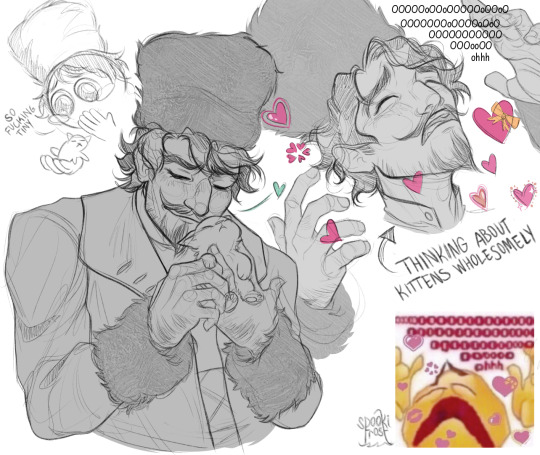

sometimes i think a lot about plot-irrelevant sentences
#guardians of childhood#rotg#rotgoc#nicholas st north#ombric shalazar#a certain different giant cat is coming eventually#my joke-y headcanon is that there was another kitty north did the same to that escaped before he could de-giant it#and being found/raised by ppl-eating yule witch gryla led it to be the rude ppl-eating immortal yule cat#the irony. the baby to estranged foe arc#i went from 100% kidding about this to like 68%
456 notes
·
View notes
Text
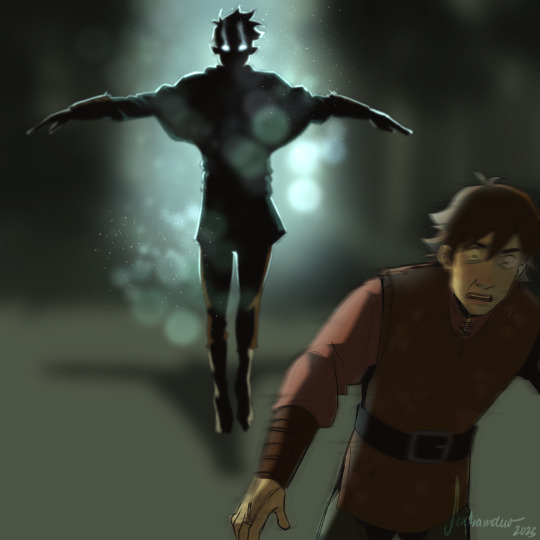
That scene in fics where Jack gets his powers back. But it’s low key chilling af and Hiccup reacts as any superstitious Viking would do.
3K notes
·
View notes
Text
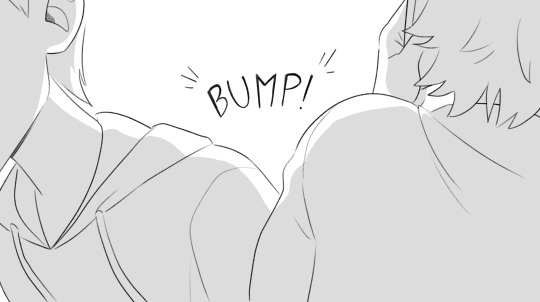


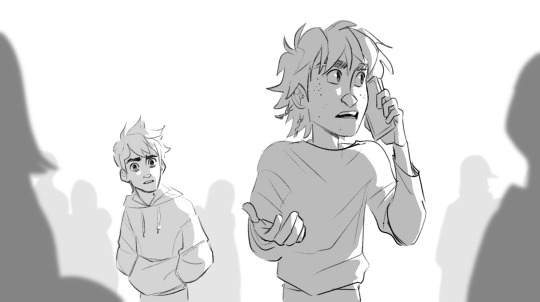
Hypotetical meet-cute that turns into Jack questioning his life and Hiccup wondering who the frick is that guy staring at him from across the street
3K notes
·
View notes
